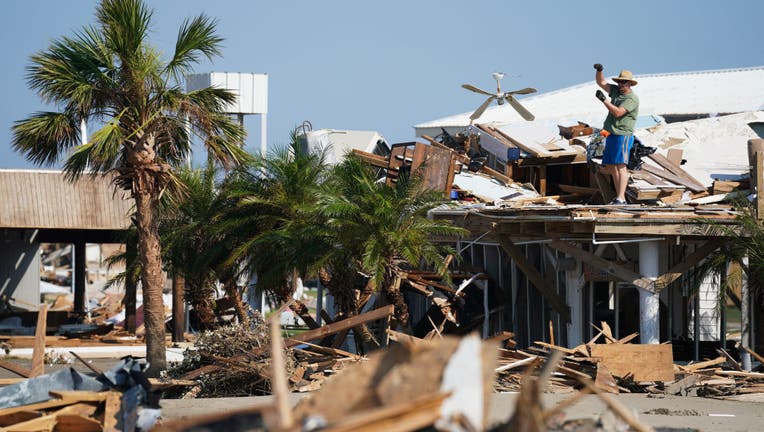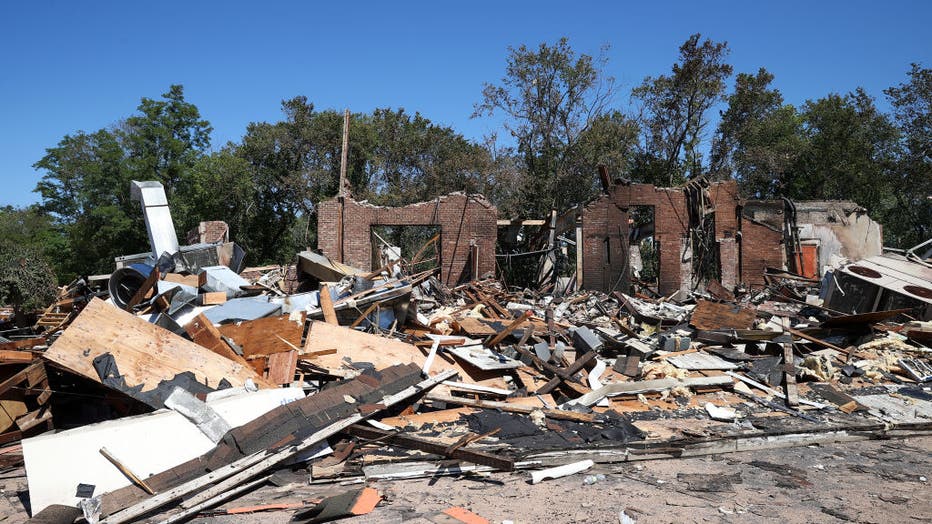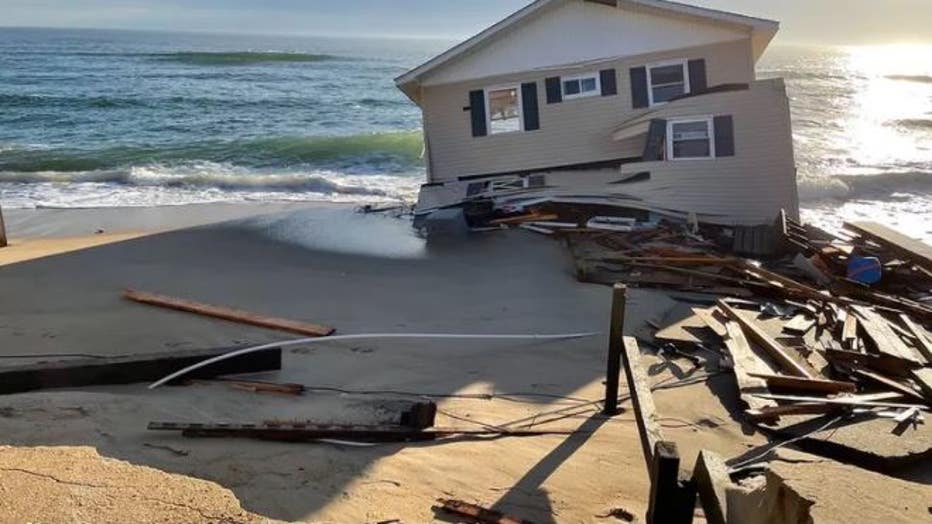Climate change rocking the insurance industry — and homeowners feel the heat

A man tosses a ceiling fan from a family member's storm-damaged house after Hurricane Ida on Sept. 4, 2021, in Grand Isle, Louisiana. (Photo by Sean Rayford/Getty Images)
The year 2021 was a staggering one for natural disasters and losses covered by insurance. More than 50 severe flood events occurred around the world, including devastating flash floods in Europe and Hurricane Ida in the U.S. — one of the costliest storms in the country’s history.
In just the first half of 2021, insured losses from natural disasters worldwide had already hit a 10-year high of $42 billion, according to the Insurance Information Institute (Triple-I). The biggest loss was related to the Texas freeze amid severe winter storms.
Then in September, Hurricane Ida and its remnants brought a path of destruction to multiple states from Louisiana to New Jersey and caused between $31 billion and $44 billion in insured losses, according to reports.
Overall, roughly $270 billion in losses were attributable to natural catastrophes in 2021, according to new estimates from reinsurance giant Swiss Re Group. Flooding, tropical cyclones, extreme cold and heat, wildfires and severe thunderstorms were among such disasters. Swiss Re said insurance covered $119 billion of last year’s economic losses, the fourth-highest on record, including $111 billion in compensation for damage from natural catastrophes.
The U.S. Environmental Protection Agency notes how rising global average temperatures are likely to drive more frequent and intense weather events, such as heatwaves and large storms — having disruptive impacts across many aspects of society. Loss of life, illness and the displacement of populations are among the most profound, but the financial loss can have lasting impacts too.
"With natural catastrophes leading to billions of U.S. dollars in losses — not to mention more extreme weather conditions expected in the years to come — the human costs are profound. But also the financial losses have a big impact," Jerome Haegeli, the group chief economist for Swiss Re, told FOX Television Stations.
"Climate change, let’s not make a mistake, is the number one long-term economic risk," Haegeli added.

An exploded restaurant is seen with all debris after heavy rain and storm from remnants of Hurricane Ida in Manville, New Jersey, on Sept. 7, 2021. (Photo by Tayfun Coskun/Anadolu Agency via Getty Images)
Homeowner’s insurance policies skyrocketing, dropped
Homeowners are also feeling the impacts of climate change — particularly in areas prone to wildfires, hurricanes or other natural disasters who have seen massive increases in their insurance policies, less coverage availability, or outright cancellations.
The average U.S. homeowner’s insurance premium increased by 2.2% between 2018 and 2019, according to data published this month by the National Association of Insurance Commissioners, a U.S. regulatory organization by the chief insurance regulators from the 50 states, Washington, D.C. and U.S. territories. Other estimates show the average cost of home insurance rose at a faster rate than inflation, jumping 11.4% between 2017 and 2020.
Globally, property insurance premiums are forecast to increase by 5.3% annually through 2040, with climate risks being "a main driver," according to estimates from the Swiss Re.
For those in the wildland-urban interface (WUI), or areas where vegetation butts up against homes and communities, increasing the threat of wildfire, homeowners feel such shocks on a regular basis. Some insurance companies have moved toward non-renewals in an effort to get risky homes off of their books.
The policy for Tobias Freccia's home in rural San Mateo County, California, was abruptly canceled in June 2021. That gave him just three months to find a replacement for his $5,700-a-year policy. It took two months, but his broker finally got a quote: a mind-numbing $34,000.
"That was just not only a huge shock but something that's untenable for a family to support," Freccia told KTVU in September.
To protect homeowners from an insurance desert, California has imposed one-year cancellation moratoriums for wildfire-prone counties, meaning insurance companies can’t drop policyholders. But San Mateo County — where Freccia’s home is located — had already expired.
In Florida, where more retirees and others have flocked in recent years, the ability to get a home insured appears just as burdensome. Companies have long been paying out large insurance claim settlements for catastrophic storms, but climate change has increased the cost and caused insurers to raise premiums or move out of Florida entirely.
RELATED: Retirees strained by higher home insurance rates in Florida: Here's how to cut costs
In May 2021, the state allowed three companies to drop home insurance policies for more than 50,000 homeowners in an effort to help the companies to stay afloat financially — facing millions in reported net losses. Insurance experts told FOX 13 Tampa that increasing hurricane claims, roofing repair schemes and lawsuits were all to blame.
Republican state Sen. Jeff Brandes has been calling for more legislative steps to address the turbulent property insurance market, including giving property insurance policies more flexibility. One state bill that appears to have been indefinitely postponed would have allowed insurance companies to offer policies that only pay the depreciated value of the roof or the actual cash value it’s worth when damaged — meaning a homeowner would pay less each month, but foot more of the roofing repair bill.
Such legislation is part of an overall effort on behalf of lawmakers to prevent insurers from giving up on Florida altogether after the state claimed $1.6 billion in losses in 2020, Brandes told FOX 13.
But nonetheless, several of the state’s smaller insurers have recently gone out of business, leaving thousands of Floridians with no option other than Citizens, the government-run insurer of last resort.
What’s causing this?
The frequency and severity of natural disasters, as well as rising costs of items that go into rebuilding damaged homes, have contributed to rising homeowners' insurance costs.
Patrick Brownfield, a personal risk adviser for the insurance broker Hub International in Jackson, Wyoming, said he’s noticed home insurance premiums "have gone up significantly" within the last two to 2.5 years.
"Most carriers are really, really worried about wildfire," Brownfield told FOX Television Stations, noting how Jackson’s location in a valley just south of Grand Teton National Park, combined with the high cost of materials, has increased the price of rebuilding.
Brownfield recently helped a client get a homeowners' insurance policy for a home in the area that sold for over $12 million. The residence serves as a secondary home, meaning the insurance is already more expensive due to the dwelling being occupied less often.
"I got a [homeowners premium] for him for $69,000 a year... That was the best we could do," he recalled. "Three years ago, I could have gotten the family three quotes from really good carriers for under $25,000."
Brownfield said insurance premiums "are absolutely changing the outlook of home buying."
US revamps flood insurance to meet rising climate change risks
In the U.S., 90% percent of all-natural disasters involve flooding, according to the Federal Emergency Management Agency (FEMA). Given the risk that widespread flooding can bring to entire neighborhoods, flood coverage is typically not included in standard home insurance policies.
Congress established the National Flood Insurance Program (NFIP) in 1968 in response to the lack of availability from private insurers. The program, managed by FEMA, has several priorities, which include providing flood insurance, helping communities take action to reduce flood damage, and identifying and mapping flood risk.
Homes and businesses in areas deemed high-risk for flooding with government-backed mortgages are required to have flood insurance. The NFIP program is often the only flood insurance available in areas vulnerable to hurricanes and heavy rains, including Louisiana’s Gulf Coast.
While the program collects about $4.6 billion in annual revenue from policyholders’ premiums, fees and surcharges, it provides over $1.3 trillion in coverage, according to the Congressional Research Service.
Last year, FEMA revamped the program — which had not fundamentally changed since the 1970s — to make it more sustainable and factor in more variables to determine a home’s flood risk. Previously, rates were based largely on a property’s elevation and whether it was built in a designated flood zone.
But many experts say that didn’t accurately capture flood risk, noting many communities damaged in recent hurricanes were not in such areas.
The new system takes into account the type and frequency of floods, how far a home is from a water source and the estimated cost to rebuild after damage. FEMA said the change will lead to fairer pricing since smaller homes cost less to replace.
Globally, extreme flood events continued to drive high losses in 2021 — yet 75% of flood risks around the world remain uninsured, according to Swiss Re Institute's latest report. It warns that climate change is expected to cause "more frequent and more extreme weather events" with growing populations and rapid urban development in disaster-prone areas.
In the U.S., about 40% of the total population lives in coastal counties — vulnerable areas identified by the U.S. Environment Protection Agency as facing increasing threats from climate change.

The collapsed house is pictured in a provided photo from Cape Hatteras National Seashore on Feb. 9, 2022, in Rodanthe, North Carolina. It said visitors should use caution on the beach and in the ocean between the villages of Rodanthe and Salvo due to
Insurance industry’s response to climate change
The insurance sector, which by nature measures risk, is paying attention to such hazards that climate change presents — both in its investments and liabilities with property and casualty underwriting.
For reinsurers like Swiss Re, which offers insurance for insurance companies, greater loss preparedness and climate protection are a matter of urgency. This means calling better attention to climate change within organizations, better modeling of climate change risks, and working with governments around the world to develop more climate-resilient public policies and infrastructure.
"When you think about the insurance industry, reinsurance and the primary insurance industry, there’s probably no other sector which has a more positive role to play in this fight against climate change," Haegeli said.
An analysis by Deloitte suggests several actions for the insurance industry to better implement, including working with administrative agencies and builder associations more closely to discourage development in higher-risk zones. At the same time, building design and materials used for development should be best suited to withstand the climate-related threats in that region.
"Retrofitting homes to make them more resilient to natural catastrophes could be incentivized through government programs," Deloitte says.
"In short, rather than making premiums unaffordable, which can lead to a rise in the number of uninsured, insurers could work proactively with administrative agencies to develop preventive and adaptive public policies supporting a climate-resilient future," the analysis adds.
Swiss Re is among the risk managers, insurers and investors who have called for the insurance industry as a whole to take leadership in driving transformational changes needed. The company was a founding member of the UN-convened Net-Zero Asset Owner Alliance and has committed to transitioning its entire investment portfolio to net-zero greenhouse gas emissions by 2050.
"However, no single actor, industry or government can solve this challenge alone - collective action will be key," Swiss Re said in a 2021 article, titled "It's time to take action on climate change." "We must also, therefore, be more proactive in collaborating with other stakeholders from the public and private sectors to catalyze the necessary action."
Ways to lower homeowners’ insurance costs
Shop around: The Insurance Information Institute (Triple-I) suggests, first and foremost, shopping around to find the best insurer available. The National Association of Insurance Commissioners has information to help people choose insurance companies by state, including associated complaints. Once the field has been narrowed to three insurers, get price quotes.
Look for discount opportunities: Keep an eye out for potential discount opportunities from the insurer, such as senior citizen discounts, multi-policy discounts, burglar and fire alarm discounts, and even first-time homebuyer discounts.
Disaster-proof the home: Homeowners should contact their insurance agent or company representative about what steps to take to make the home more resistant to windstorms and other natural disasters.
"You may be able to save on your premiums by adding storm shutters, reinforcing your roof or buying stronger roofing materials," Triple-I says. "Older homes can be retrofitted to make them better able to withstand earthquakes. In addition, consider modernizing your heating, plumbing and electrical systems to reduce the risk of fire and water damage."
Look for private insurance if on a government plan: Those with homeowners insurance through a government plan in high-risk areas, such as those more vulnerable to coastal storms, wildfires or crime, should check with a private insurance agent or company representative to see if they’re interested in the new business.
"You may find that there are steps you can take that would allow you to buy insurance at a lower price in the private market," Triple-I says.
When buying a home, consider insurance costs: Is a potential new home close to a fire hydrant? Is it located in a community with a professional fire department over volunteers? Are the home’s electrical, heating and plumbing systems less than 10 years old? Choosing wisely where one buys a home could cut premiums by 5% to 15%, according to Triple-I.
"If you live in the East, consider a brick home because it's more wind resistant. If you live in an earthquake-prone area, look for a wooden frame house because it is more likely to withstand this type of disaster," the institute says.
This story was reported from Cincinnati.


